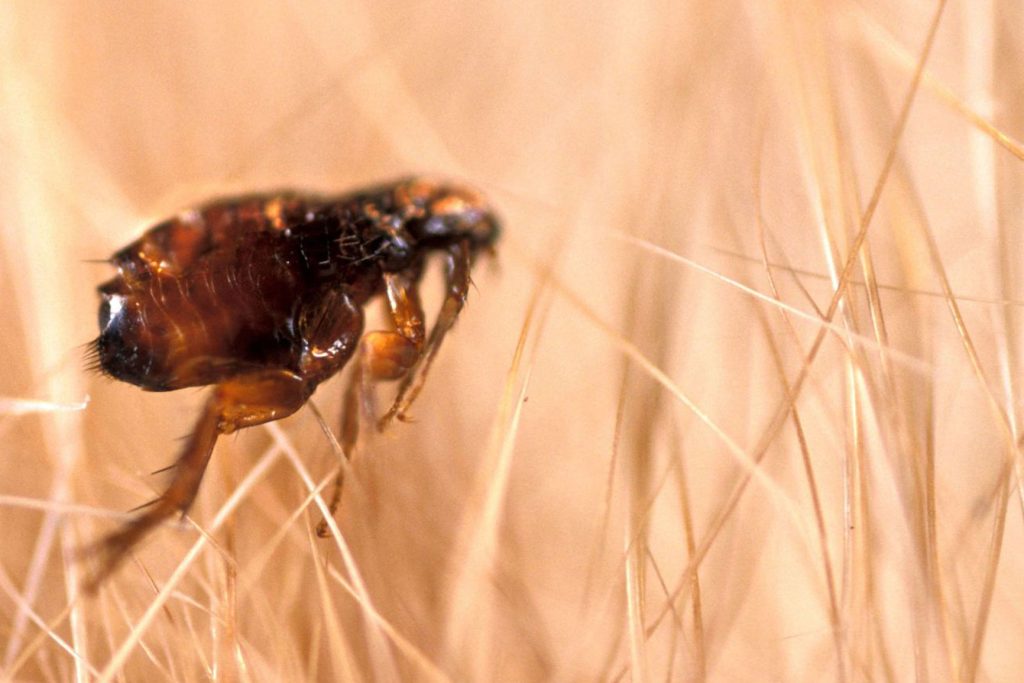The Life Cycle of Fleas
Fleas bite. Pets spread fleas and their eggs throughout your home. Fleas can be found in your furniture as well as your pets. They lay approximately 50 eggs per day on your pet and can quickly infest your home.
● After each blood meal female fleas can lay 11 to 46 eggs a day on their host animal. Some eggs may fall off from the host after they dry.
● Fleas complete metamorphosis in 4 life stages: egg, larvae, pupae and adult.
● The larvae have three instars, and the third instar pupates.
● The entire life cycle can take from 14 to 174 days depending on environmental conditions.
● Eggs hatch in about 10 days with the developing larvae feeding on the adult feces which contains dried blood.
● Depending on environmental conditions, this can be a period of seven days to several months.
● When mature, they spin silk-like cocoons that contain surrounding debris that aid in camouflaging the pupae.
● Under ideal conditions, adult fleas can emerge from pupae after 5 days.

Did you know fleas only eat blood, a female flea can start producing eggs within 24-48 hours after their first blood meal, can lay up to 50 eggs per day, can jump as high as 8” vertically, can jump 30,000 times consecutively without taking a break, and only lives about 100 days if they have a host? Ten females can produce over 250,000 fleas within 30 days.
Fun Fact
Pre-Treatment for Flea Infestation
To control flea infestations, it is necessary to follow the pre-treatment steps listed here so your home will be prepared for treatment when the technician arrives. If applicable, cut the grass prior to treatment. Our flea treatments consist of 3 services. Please allow 21 days for the treatment to reach its maximum effectiveness. There can be any number of fleas going through various stages of their life cycle at any given time. If there is a problem after 21 days, please give our office a call & we’ll be happy to help.
● To start, consult with your veterinarian regarding the proper flea shampoo and/or flea collar to use on your pet. It is very important to treat pets at the same time so their not continuing to spread fleas one to the other.
● Wash all the pet’s bedding and inform our pest control technician of the indoor and outdoor areas where your pets normally rest.
● Vacuum all carpeting and mop wood and tile floors, including along the walls and inside closets. When done vacuuming put a small amount of flea powder on the floor and vacuum it up to kill the fleas inside the bag or container.
● Vacuum under furniture, between and under cushions.
● Vacuum cleaner bags should be closed tightly and disposed of in an outdoor trash receptacle. If using a vacuum with a canister, take it outside and empty contents into a bag, tie it tightly and discard. Wash the reusable canister with hot water. Remember, when you’re done vacuuming, put a small amount of flea powder on the floor and vacuum it up to kill the fleas inside the bag or container.
● Cover fish tanks with wet towels and turn off pumps until reoccupying the home.
● Pick up all pet food bowls, pet toys, children’s toys and other items off the floor as well as the yard if the exterior is being treated. This includes picking up items from floors inside closets and under beds and inside kennels and outdoor pet houses.
● Strip all bed linens from any beds where the pets rest or lounge and wash in hot water.
● Cover and store any open food products, dishes or utensils before service is rendered.
● Remove all caged pets from your home (birds, reptiles, hamsters, etc.) before service is
rendered and until the waiting period of at least 4 hours has elapsed.
● Be prepared to leave your home or apartment during treatment. Stay out of the house for a period of at least 4 hours.
● Babies and children 5 and under should stay out of the home for at least 12 hours. Be sure when you return to safely crack windows just enough to ventilate the home.
Post Treatment Steps
● Vacuum lightly for 14 days and be sure to vacuum up a little bit of flea powder.
● Vacuuming daily will get the fleas through their life cycle more quickly due to the vibration and making them more susceptible to the insecticide.
● Vacuuming the carpet can help to remove the eggs that drop there from fleas on the pet.
● Vacuuming will remove a few larvae as well as the debris that the larvae eat.
● Vacuuming will also cause the adult fleas to come out of their cocoons while the carpet treatment is fresh and effective.
● Be sure to keep your lawn cut short
Download PDF
Pre-Treatment for Flea Infestation




